THE NEWS BUILDER: Turning the canvas into a press release
Once the News-Worth Canvas is all filled up, you have the building blocks necessary to create remarkable stories with very clear elements of news-worth. This elements will be the content of an amazing press release with boosted media interest.
The main purpose of a press release is to help the journalist understand why the story is newsworthy. However, if you are not trained as a journalist, it can be difficult to turn all those great ideas into a comprehensive press release that clearly shows all the newsworthy elements. That is why we created a second tool: The News-Builder.
The News-Builder leverages what journalists call the Five 5Ws of Journalism: WHO?, WHAT?, WHERE?, WHEN? and WHERE?. With the News-Builder, you will craft a press release simply by arranging the elements from the News-Worth Canvas into the Five 5Ws and then into an amazing press release.
STEP 1: The Five Ws
The first thing Journalism students learn in university is the existence of something called the Five Ws of Journalism. In the mind of the journalist, the whole story revolves around these five questions: WHO, WHAT, WHEN, WHERE, WHY
That is why the News Builder is shaped as a pentagon with five sides, one for each W. This way, you build up a comprehensible inventory of blocks following the same principles as professional journalists.
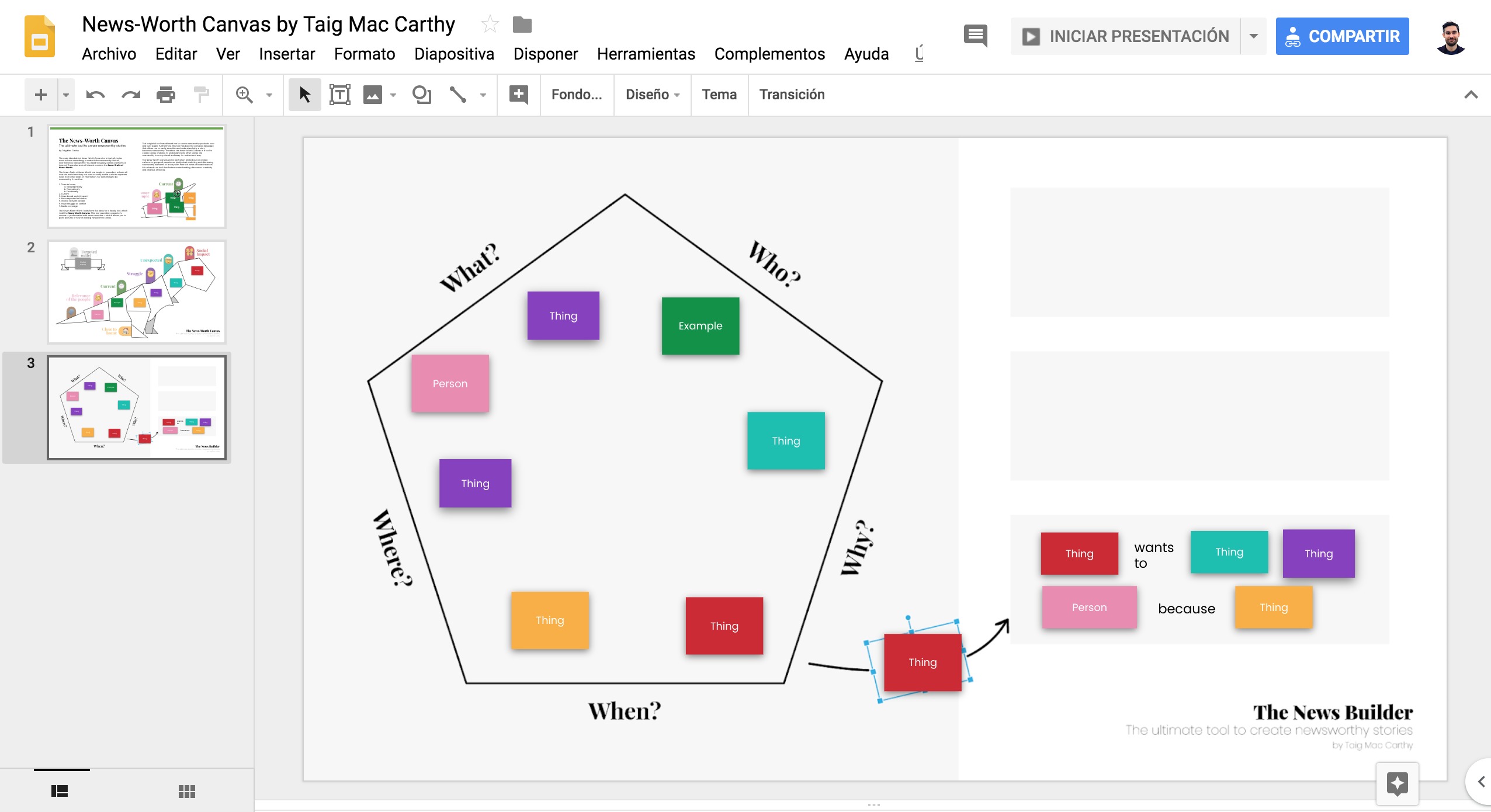
News Builder template in Google Slides - https://bit.ly/newsworth-canvas-slides
To properly execute this step, you must place the elements from the dinosaur into the five slots of the pentagon. Some elements might fit into two places, in which case you can place them in between or in the middle.
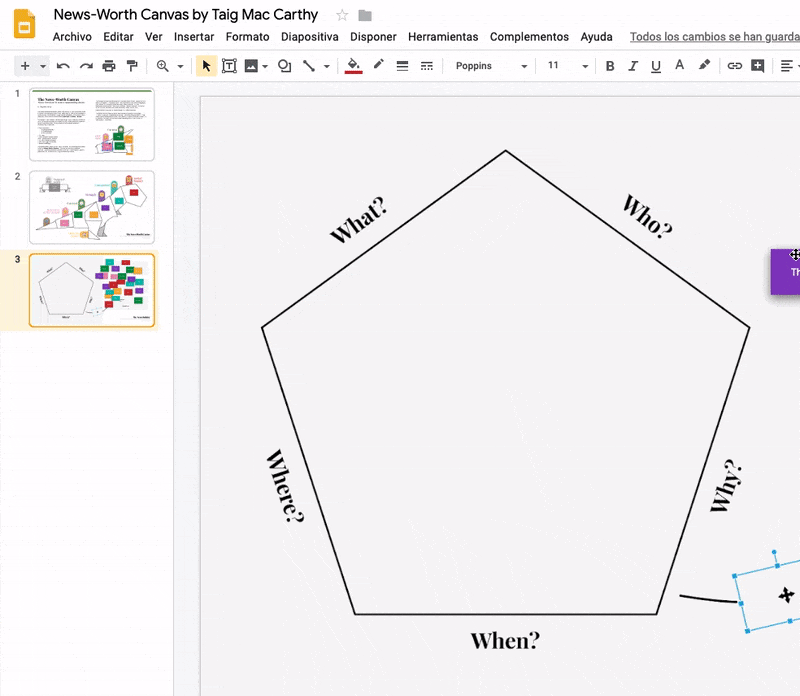
…simply rearranging the elements into the pentagon… — https://bit.ly/newsworth-canvas-slides
Let's take a look at each W one by one:
<h3>WHERE?</h3><p>If you tell a friend that you found a dinosaur, the first question they'll ask is _WHERE?_</p><p>The WHERE is very much related to the _Close to home_ trait of news-worth, but it can be tied to the _Broad impact_ or even the _Conflict_, depending of the story.</p> <p>Since it's a basic element of the story, the _WHERE_ will always be in the heading of every article.</p> <h3 >WHEN?</h3> <p>If you see a dinosaur, people want to know _WHEN_ you saw it.</p> <p>Journalists care very much about _WHEN_ the story takes places. It's quite self explanatory: news need to be new. If you found a dinosaur, but it died millions of years ago, it's suddenly not interesting, right?</p> <p>Since it's a basic element of the story, the _WHEN_ will also be in the heading of every article, although it's usually implied in the verb.</p> <h3</h3> <p>If you are shocked because you saw something amazing, people want to know _WHAT_ you saw. If it was a dinosaur, then it's pretty remarkable. But if it had been a vending machine it wouldn't be so awesome, would it?</p> <p>The _WHAT_ is a central element of the story and it must also appear in the heading of every article.</p> <h3 >WHO?</h3> <p>If someone finds a dinosaur, people want to know WHO found it.</p> <p>You cannot have a story if there are no characters. That is why the WHO will be acknowledged in the heading and the first paragraph of the story.</p> <p>This is highly related to the trait of _Relevance of the people involved_, and it can also be tied to the _Broad impact_ trait and the _Struggle or conflict_, depending on the story.</p> <h3 >WHY?</h3> <p>If you ever see a dinosaur, people want to know _WHY_ was the dinosaur was there, or rather _WHY_ you were there.</p> <p>The reason for something happening is very important. Therefore, the _WHY_ is frequently regarded in the heading and the first paragraph of the press release.</p> <p>Also, the _WHY_ is very important for you as an entrepreneur, because it gives you the chance to talk about your brand. You can say that you found a dinosaur because you were working in blockchain or whatever your company does. Any trait from the News-Worth Canvas can potentially be an answer to the _WHY_.</p>
Get the full book
News-Worth Creation
Access premium content
- Full version of the content
- Bonus resources: templates, tips...
STEP 2: The Heading
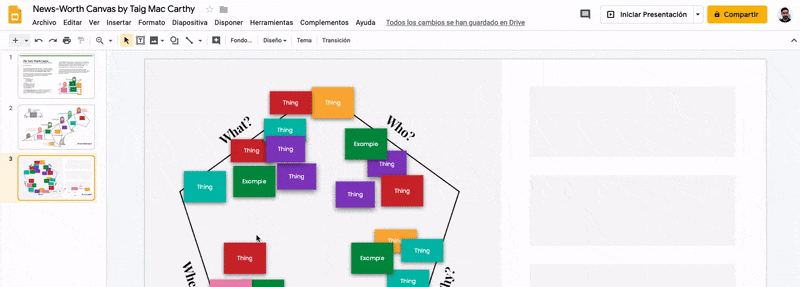
…making a collage of newsworthy elements… — https://bit.ly/newsworth-canvas-slides
The most important task of a journalist is to look at the story and decide what information goes into the heading. It is that simple. A good journalist understands what readers want and knows how to summarize it in a couple of sentences.
The News-Builder will allow you to create the heading of the press release. The heading is the core of the story. As you will learn in the following pages, the whole press release is basically an extension of the heading.
Furthermore, the role of the press release is dramatically changing and many experts believe that the press release will completely disappear in the following years. According to a study published in 2018, almost half of US based journalists do not rely on press releases at all. This is most likely because the press release is too long of a read and journalists want to understand immediately why the story is newsworthy.
Once you have all the newsworthy elements in the pentagon, you can simply drag them to build headings and create amazing stories. Think of it as making a collage of newsworthy elements which, arranged in the right order, create stories with great media interest.
Feel free to use the builder in a Google Slides format, if you are working remotely with your team.

News Builder template in Google Slides - https://bit.ly/newsworth-canvas-slides
Let's see some examples.
An ex-Tesla engineer created an FDA-compliant cure for hangovers. June 25 2017. San Francisco Gate.
| W | Element of the story |
|---|---|
| WHAT | created an FDA-compliant cure |
| WHERE | it's implied that it is the US |
| WHO | Ex-Tesla engineer |
| WHY | for hangovers |
| WHEN | right now implied in the verb |
| W | Element of the story |
|---|---|
| WHAT | Has A Noble Mission |
| WHERE | - |
| WHO | Startup |
| WHY | Helping Unmarried Couples Find Privacy |
| WHEN | right now implied in the verb |
Neon-Blue Wine Gives Spanish Start-Up a Regulatory Headache. March 5 2017. The New York Times.
| W | Element of the story |
|---|---|
| WHAT | Gives Spanish Start-Up a Headache |
| WHERE | Spanish |
| WHO | Neon-Blue Wine |
| WHY | Regulatory issues |
| WHEN | right now implied in the verb |
In all cases, the heading sums up the story in a sentence by focusing on the newsworthy elements and acknowledging the five Ws.
There are many ways of arranging the Five 5Ws. You should try many combinations, such as:
- WHERE WHO created WHAT to WHY
- This WHAT WHO is WHY in WHERE
- WHAT against WHO WHY
- WHERE will be WHAT after WHO WHY
- Your WHAT might be WHY thanks to WHO
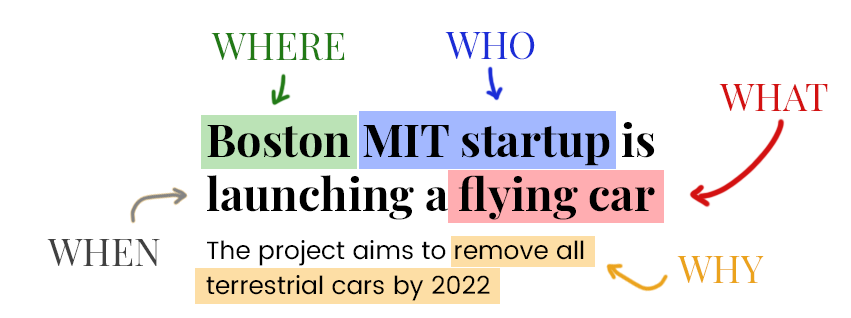
As you can see, it's really a matter of arranging and rearranging the 5Ws until you come up with a combination that really makes the story stand out. It may take you several attempts until you finally get it, but there is no way of not coming up with something newsworthy if you have performed each step correctly.
TIPS
If something is not in the canvas, it has no business in the press release
The reason for doing the canvas exercise before building the press release is precisely to avoid including information that is not newsworthy.
There is not a module in the News-Worth Canvas for the price, right? Nor for the distribution channels or the mission statement of the company. That is because they have no business in the press release. If something does not directly add up to the Broad Impact, the Conflict, the Proximity or one of the other seven traits of the News-Worth Canvas, it has no value from a journalistic point of view and you should keep it for yourself.
Focus on events, not things
If you want to succeed at achieving free media coverage, you need to understand that press releases — or news articles for that matter, cannot feel like advertising. Your press release needs to tell a story. You must focus on an incident: something happening — as opposed to describing something constant like a company or a product.
We can't stress enough the importance of this tip enough. When writing your press release, you must be telling a story about a newsworthy event that has been caused by your project, or an event in which your project is involved. But the main focus should be on the event, not the thing itself.
For example, no editor will publish an article about an electric car. But if the story deals with an event such as a new technological development, a traffic incident or a tweet by a relevant person in which an electric car is involved, that will easily make it to the news.
A good trick to help you think like a journalist is to make the product the WHY and the newsworthy event the WHAT, instead of the other way around. This way, you present the newsworthy event as the main thing, and the product as the trigger that caused the event — making it easier for the journalist to picture why the story is interesting for their readers. Look at the following example:
❌ Instead of:
Local startup creates a new product that makes people angry
| W | Element of the story |
|---|---|
| WHAT | Creates a product |
| WHERE | Local |
| WHO | Startup |
| WHEN | right now implied in verb |
| WHY | makes people angry |
✅ Try something like:
Local startup makes people angry with a new product
| W | Element of the story |
|---|---|
| WHAT | Make people angry |
| WHERE | Local |
| WHO | Startup |
| WHEN | right now implied in verb |
| WHY | To create a product |
You can try many different combinations until you come up with something that works.
Talk about the team in terms of their news-worth
Something worth mentioning is that, when you are writing a press release, you should introduce the people in the team in terms of what is newsworthy. For instance, you should avoid using titles such as CEO or CMO. Instead, you should describe yourself in a way that reinforces the point of the story.
If the story is about your company being the underdog, introducing yourself as a young student may be a good idea. But if you are trying to appear as a leader of opinion, presenting yourself as an experienced engineer would be the best course of action.
It's also important to bear in mind that projects created by minorities can add up to the news-worth of the story. The same goes for war veterans and other collectives that society cares about, such as people with disabilities.
Veteran with PTSD creates jewelry to empower women. FOX Business. September 25, 2018.
Man with Down syndrome starts million-dollar sock company. Today.com. Jan.24.2018.
So if your project happens to be somehow related to one of those collectives, it may be a good idea to mention this in the press release.
Add tasty sound bites
All media outlets are on the look-out for that one snappy quote or compelling sound bite that will stick in the minds of their viewers, listeners or readers.
A great quote or sound bite on top of an already newsworthy story can see it move close to the front of the newspaper or the top of the news bulletin.
Test it
Don't wait until you have the perfect press release; get your story out there as soon as possible and improve it with every interaction.
You will be surprised the first time that someone publishes your story. They will fixate on features that you had overlooked, or they might totally ignore something that you thought was very remarkable. They will also come up with nice ways of phrasing some information that you hadn't thought about.
Chances are you will end up rewriting your press release after someone publishes the first article. So don't wait until you have the perfect press release; get your story out there.
EDITORIAL GUIDELINES FOR NEWS ARTICLES
Writing news articles is a science, not an art. When we took our first journalism course at university, what surprised us the most is that there is method to it. Journalism is such an old profession that it has been totally figured out. There are very well defined principles and rules for writing news articles. And once you get it, you are in for the win.
Structure of news articles
Just as humans have a head and a body, news articles have a Heading and a Body. The Heading has no more than 30 words, and is written in big and bold letters, while the body is a larger text in a normal font size.
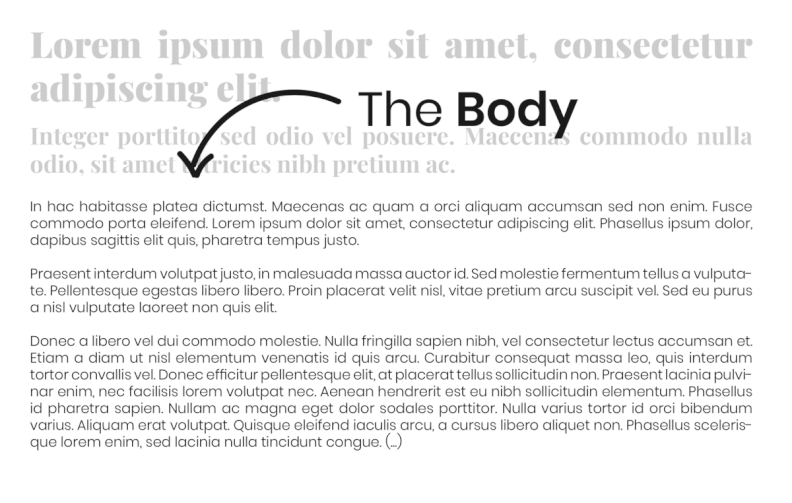
Heading and body, the basic outline of a news article
The heading sums up the whole story, so you should include as many of the five Ws as possible; ideally all of them. Headings must be catchy, but also informative, and they should immediately explain why the story is newsworthy.
The Heading
Readers decide if they are going to read an article just by browsing headings, so journalists can't take the risk of being unclear or uninteresting.
The heading has two parts: the title and the Subtitle.
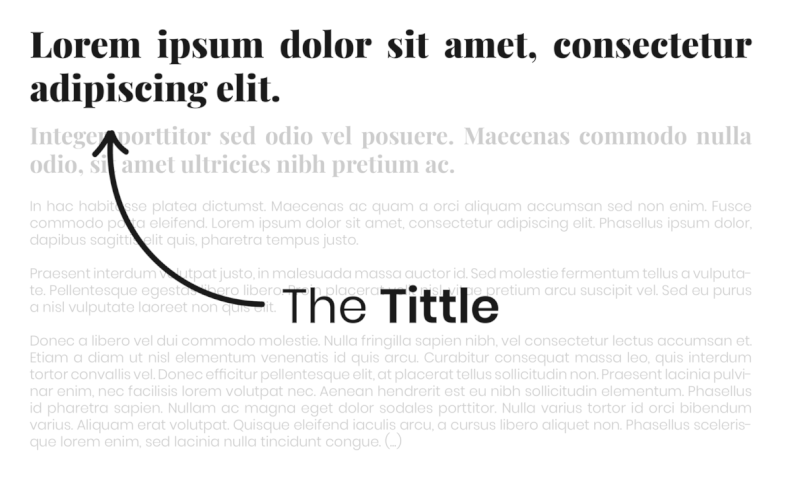
title and subtitle, the two parts of the heading
The title is the first sentence that anyone will read. It covers the most newsworthy elements of the article and it's written in big and bold letters.
The subtitle is the second sentence and it must be written in a smaller font size. You can add some extra Ws if you didn't manage to fit them nicely in the title. Otherwise, it's common to include quotes in the subtitle.
In many cases, instead of one subtitle, articles include three or four subtitles. This depends on the outlet's guidelines and it's a trend that is becoming more and more popular in digital media. It is also possible that the journalist decides not to publish a subheading in the story at all, but you should always provide it in the press release.
Once you have the title and the subtitle, the Body is a piece of cake.
The Body
The body is also divided into two main parts, the 1st paragraph and the 2nd paragraph. Just as with the heading, the most important information goes in the first paragraph, and less important information goes in the second paragraph. Then, the rest of the text simply adds more information, although most of the audience won't care to read the whole thing.
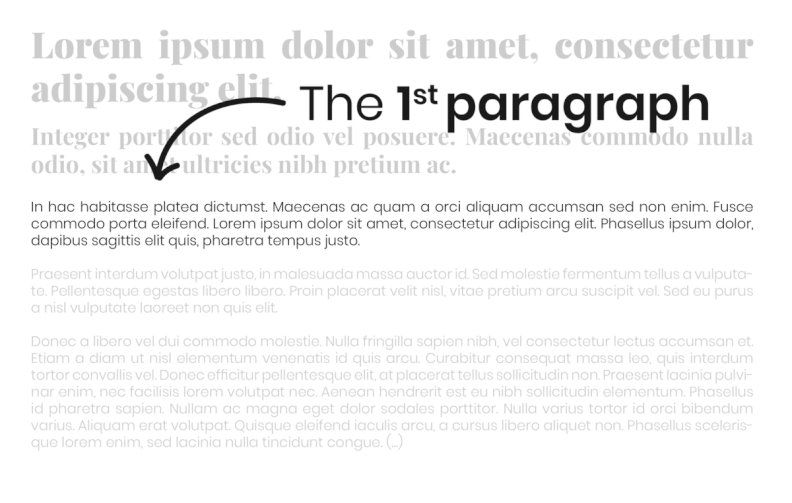
1st paragraph, 2nd paragraph and rest of the body, the two parts of the body
The content of the Rest of the Body is quite freestyle. You can add extra information at will. But remember: think of your press release as a story, not a product description. Don't bother including info about the price or the team behind your product unless it's newsworthy, in which case it should go in the first paragraphs.
Main idea and secondary idea
If you have been paying attention, you might have picked up on a very important pattern: the heading and the body contain the same information — and more specifically, the title contains the same information as the 1st paragraph, and the subtitle contains the same information as the second paragraph.
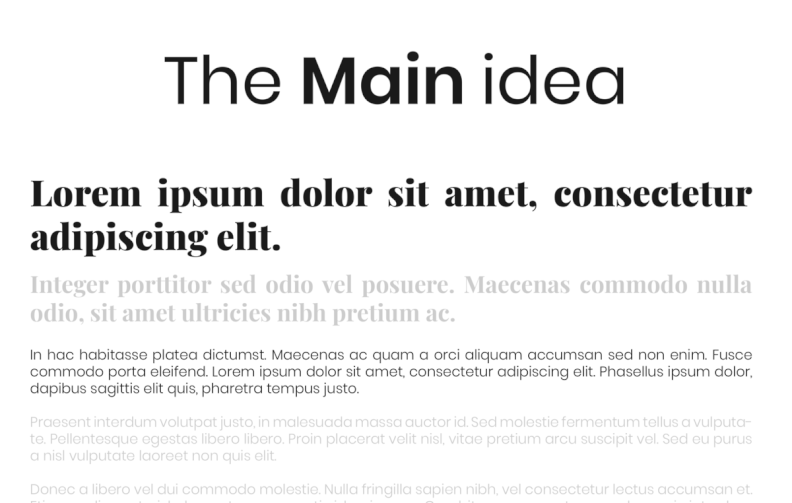
Title = 1st paragraph
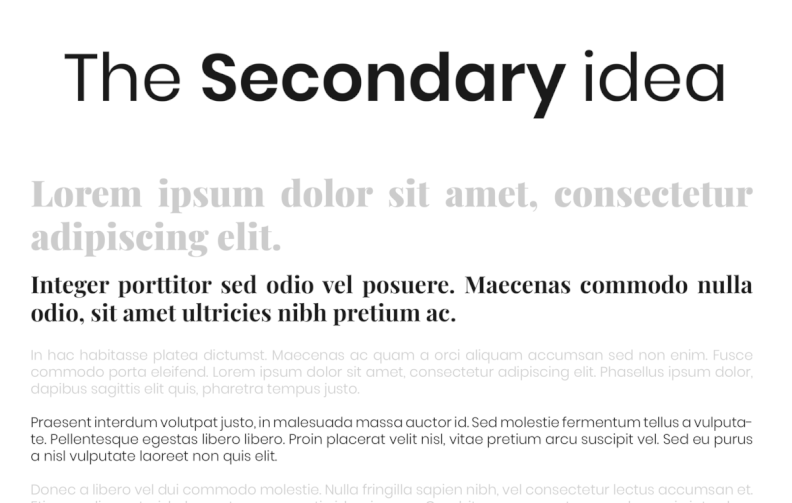
Subtitle = 2nd paragraph
This is why it is so easy to write the press release once you have the title and the subtitle. This structure is called The Inverted Pyramid and it's an industry standard that will work for media outlets all over the world.
The point of the Inverted Pyramid is to mention the most important, interesting or attention-grabbing elements of a story in the beginning of the article. That means opening up with the 5Ws: WHO, WHEN, WHERE, WHY, WHAT, and HOW, but in a way that it is not just informative, but also eye-catching.
Once you have the heading, writing the first paragraph should be a piece of cake. It's basically repeating the same info, but adding some extra information.
For instance:
An ex-Tesla engineer created an FDA-compliant cure for hangovers. June 25 2017. San Francisco Gate:
Sisun Lee loved his job as an engineer at Tesla. He had absolutely no intention of quitting and starting his own company. But what started out as a fun side project to find a cure for hangovers has grown so big, he felt he had to quit his job this week and launch a company. On July 5, his startup Morning Recovery, will be open for business, where it will sell an FDA-compliant hangover cure.
As you can see, the 1st paragraph repeats the same information as the title, and it adds some details. Otherwise the first paragraph is pretty much the same information as the heading.
Likewise, the second paragraph is a zoom-in on the subheading. Just as the first paragraph repeats the heading, the second paragraph has the same information as the subheading.
Rest of the text
From the third paragraph on, you can add your personal touch. For instance, you can give voice to the people involved in the story. You can quote yourself saying something catchy that reinforces the main idea of the article. The 3rd paragraph is usually where quotes go, giving you a chance to emphasize on the subjective aspects of the story and adding up to the conflict, add some emotional drama or even comedy — whatever suits the story best. Like in this case:
But instead suffering from hangovers, his Korean buddies turned him onto the hangover cure drinks that are popular there. Those drinks worked for him, Lee told Business Insider. "The next day, I woke up feeling great”.
Font family
Regarding the font family, use something ordinary like Arial, Helvetica or Verdana, both for the title and the body. The color should be black over a white background. Pretty straightforward.
Don't try to be artsy with the design — it will do you no good. 78% of journalists don't like emails and press releases with emojis, according to a survey from MuckRack. You need to make it as easy as possible for the journalist to copy/paste, so adding custom fonts and colors is only going to complicate the task.
Font size
About the size, the heading should be way bigger than the body and in bold letters, while the subheading would be somewhere in the middle. I would recommend the following font sizes:
| Section | Font size |
|---|---|
| Heading | 40 to 50 pixels |
| Subheading | 20 to 30 pixels |
| Paragraphs | 14 to 18 pixels |
Here is a press release done by someone in my team following this guide:
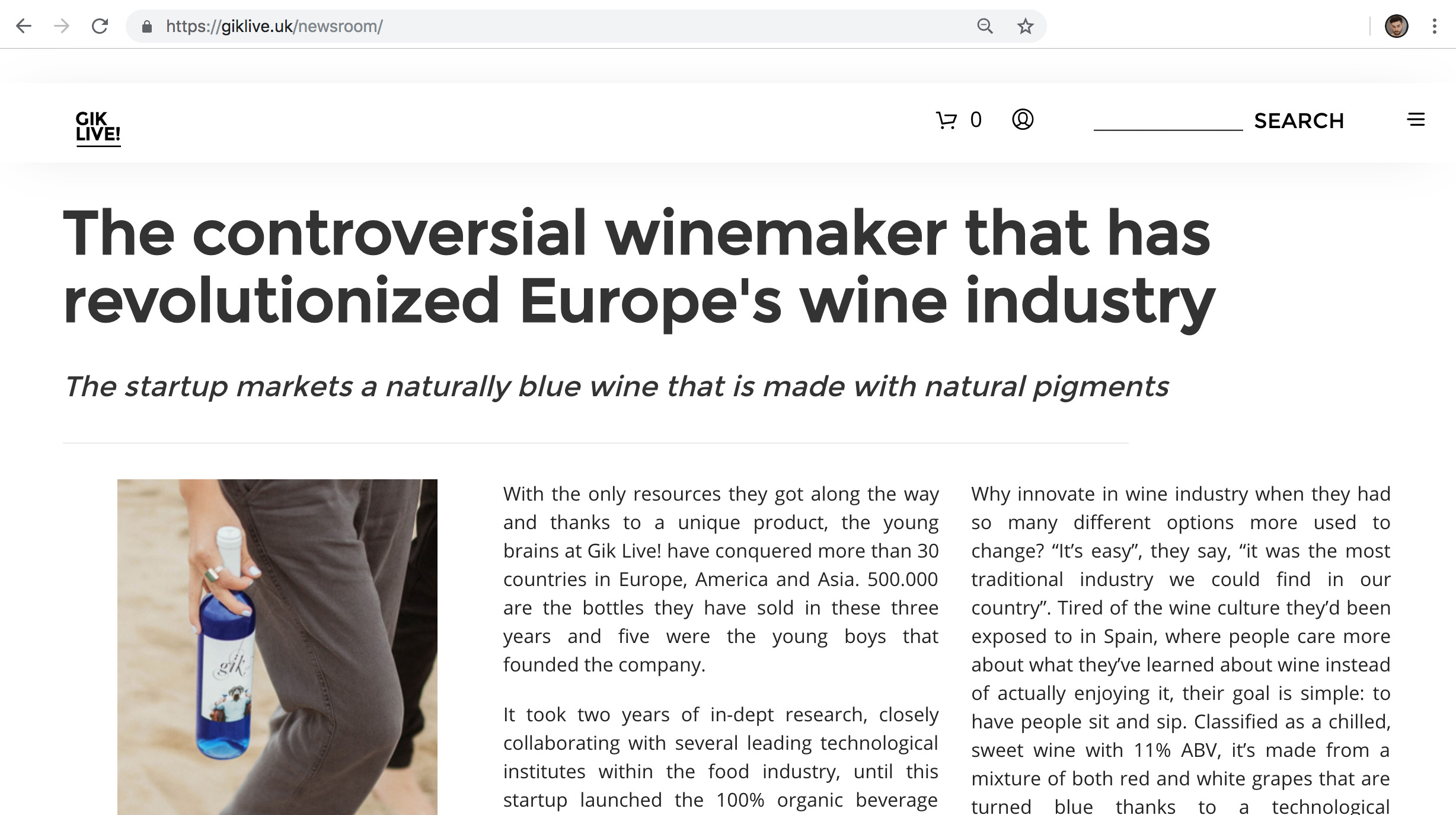
giklive.uk - Press release
This is the styling in CSS. Your designer should know:
h1 {
font-size: 1.6em;
font-style: normal;
font-weight: 700;
}
h2 {
font-size: 1.2em;
font-style: italic;
font-weight:400;
}
p {
font-size: 1em;
font-style: normal;
font-weight: 400;
}
Length
Articles' length vary a lot, but I recommend you to stick to the following guidelines to avoid making it too long or too short.
| Section | Number of words | Content |
|---|---|---|
| Heading | 10 to 20 | Main Ws |
| Subheading | 10 to 20 | Secondary Ws |
| First paragraph | 200 to 350 | Same as heading |
| Second paragraph | 200 to 350 | Same as subheading |
| Third paragraph | 350 to 600 | Further info |
| Picture | No words | Visual explanation |
| Fourth paragraph | 350 to 600 | Further info |
| Fifth paragraph | 350 to 600 | Further info |
| Contact info | 3 to 10 | Name, phone, email |
Quotes
At universities, journalists are trained to refrain from including their own opinions in news articles. They cannot say that your product is good or bad. Instead, they must interview people with different opinions and use their quotes.
Quotes are usually included in the second or the third paragraph of the press release, but they are frequently added to the title, specially when the WHO is the main element of news-worth in that story.
For instance:
Tiny Device Is a ‘Huge Advance' for Treatment of Severe Heart Failure. 2018/09/23 New York Times
As you can see, the words Huge Advance are quoted because the writer should refrain from making those claims. This also happens along the article:
“It's a huge advance,” said Dr. Howard Herrmann, the director of interventional cardiology at the University of Pennsylvania, which enrolled a few patients in the study. “It shows we can treat and improve the outcomes of a disease in a way we never thought we could.”
The quotes can also be stated without quotation marks, if it's written in such way that it's clear that it's a claim done by another person.
This New Hampshire Startup Says It's Building The iPod Of Robots. 2018/07/17. Forbes
Anyway, journalists cannot reflect their own opinions in their articles — they must stick to the facts. This is why quoting people is the only way to add opinions to the story, making the characters even a bigger part of it.
TEMPLATES
All press releases follow the same principles. So even if there is no template that magically works for every story, there are a few combinations that may serve as inspiration or a place to quick-start your press release from.
Please don't let these templates ruin your creativity. Each story is unique and the combinations of newsworthy elements are infinite. So mess around with your own ideas and bounce them around with people in your team before resorting to the templates.
| Section | Content |
|---|---|
| Heading | WHERE WHO (your company) created newsworthy-WHAT (your product) |
| Subheading | The project aims to WHY |
| First paragraph | The WHERE WHO-with-more-words has just created a WHAT-with-more-words that explanation-on-why-the-WHAT-is-newsworthy |
| Second paragraph | “We want to emotional-WHY”, explains WHO. As it turns out, more-information-on-the-issue,-ideally-with-facts-and-figures. |
| Rest of the text | Further information on WHY and WHAT |
| Picture | Showing the newsworthy WHAT |
| Contact info | Name, email and telephone number |
Lets see how an article done with the aforementioned template would look:
Boston MIT startup is launching a flying car The project aims to remove all terrestrial cars by 2022
The Boston startup FLYCAR with the help of the MIT has just created a vehicle that can transport passengers through the air and costs the same as a regular car.
”Our dream is to walk across the street without worrying about green or red lights", explains John Doe, senior engineer at the company. As it turns out, more than a 123,123 cars ride a street on average, with a growing congestion rate of 123% in urban areas. “We want to free the streets from cars and reclaim cities for pedestrians”, further comments the 24 year old Bostonian.
As you can see, you should only focus on information that is essential to understand the event at hand, not the company itself.
In this example, we don't talk about the patents or the founding team, but we mention WHERE and WHY the story is happening. About the product, we only mention facts that help understand why the story is newsworthy. I wouldn't explain how the car flies, but I do mention that it is cheap, because that is what makes it impact over a broad audience.
Always focus on the elements that make the story newsworthy. Think like a journalist, not like a founder. You don't want to explain the product, you want to help the journalist identify the elements of the story that are newsworthy. That is what the press release is for.
Let's try with another template:
| Section | Content |
|---|---|
| Heading | This WHERE WHO (your company) is WHY |
| Subheading | Their WHAT (your product) WHEN |
| First paragraph | In WHERE-with-more-words WHO-with-more-words is WHAT that will WHY-with-more-words |
| Second paragraph | Their WHAT-with-more-words that will “emotional-WHY”, explains WHO. As it turn out, more-information-on-the-issue,-ideally-with-facts-and-figures. |
| Rest of the text | Further information on WHY and WHAT |
| Picture | Showing the newsworthy WHAT |
| Contact info | Name, email and telephone number |
This is what the same article would look like written with the second template:
This Boston Startup Wants To Kill Your Car The flying vehicle prototype has just been launched and it will be in stores by end of the year
In an industrial park in Boston, Massachusetts, John Doe is putting the final touches to a flying electric vehicle that he believes will be the end of all terrestrial transportation.
The flying car, which costs no more than a regular car, will "put an end to the monopoly of cars in our streets", as explains John Doe, 47, co-founder of FLYCAR and the former lead product manager for the Tesla Model 3.
As it turns out, more than a 123,123 cars ride a street on average with a growing congestion rate of 123% in urban areas. “We want to free the streets from cars and reclaim cities for pedestrians”, further comments the entrepreneur.
It's really a matter of rearranging the 5Ws in a way that makes your story as newsworthy as possible.
